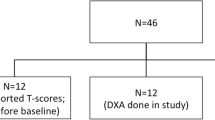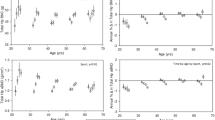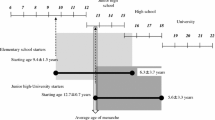Abstract
Summary
In this population-based study of 75-year-old men (n = 498), we investigated the association between physical activity (PA) early in life and present bone mineral density (BMD). We demonstrate that a high frequency of competitive sports early in life is associated with BMD at several bone sites, indicating that increases in BMD following PA are preserved longer than previously believed.
Introduction
Physical activity (PA) increases bone mineral density (BMD) during growth. It is unclear if the positive effects remain at old age. In this study, we aimed to determine if PA early in life was associated with BMD in elderly men.
Methods
In this population-based study, 498 men, 75.2 ± 3.3 (mean±SD) years old, were included. BMD was assessed using DXA. Data concerning lifetime PA, including both competitive (CS) and recreational sports (RS), and occupational physical load (OPL), were collected at interview.
Results
Subjects in the highest frequency group of CS in the early period (10–35 years), had higher BMD at the total body (4.2%, p < 0.01), total hip (7.0%, p < 0.01), trochanter (8.7%, p < 0.01), and lumbar spine (7.9%, p < 0.01), than subjects not involved in CS. A stepwise linear regression model showed that frequency of CS in the early period independently positively predicted present BMD at the total body (β = 0.12, p < 0.01), total hip (β = 0.11, p < 0.01), trochanter (β = 0.12, p < 0.01), and lumbar spine (β = 0.11, p = 0.01).
Conclusions
We demonstrate that PA in CS early in life is associated with BMD in 75-year-old Swedish men, indicating that increases in BMD following PA are preserved longer than previously believed.

Similar content being viewed by others

References
Kanis JA, Johnell O, Oden A et al (2000) Long-term risk of osteoporotic fracture in Malmo. Osteoporos Int 11:669–674
Genant HK, Cooper C, Poor G et al (1999) Interim report and recommendations of the World Health Organization Task-Force for Osteoporosis. Osteoporos Int 10:259–264
Rizzoli R, Bonjour JP, Ferrari SL (2001) Osteoporosis, genetics and hormones. J Mol Endocrinol 26:79–94
Hui SL, Slemenda CW, Johnston CC Jr. (1990) The contribution of bone loss to postmenopausal osteoporosis. Osteoporos Int 1:30–34
Kelly PJ, Morrison NA, Sambrook PN et al (1995) Genetic influences on bone turnover, bone density and fracture. Eur J Endocrinol 133:265–271
Pocock NA, Eisman JA, Hopper JL et al (1987) Genetic determinants of bone mass in adults. A twin study. J Clin Invest 80:706–710
Giguere Y, Rousseau F (2000) The genetics of osteoporosis: ‘complexities and difficulties’. Clin Genet 57:161–169
Kannus P, Haapasalo H, Sankelo M et al (1995) Effect of starting age of physical activity on bone mass in the dominant arm of tennis and squash players. Ann intern Med 123:27–31
Chilibeck PD, Sale DG, Webber CE (1995) Exercise and bone mineral density. Sports Med 19:103–122
Welten DC, Kemper HC, Post GB et al (1994) Weight-bearing activity during youth is a more important factor for peak bone mass than calcium intake. J Bone Miner Res 9:1089–1096
Bass S, Pearce G, Bradney M et al (1998) Exercise before puberty may confer residual benefits in bone density in adulthood: studies in active prepubertal and retired female gymnasts. J Bone Miner Res 13:500–507
Karlsson MK, Hasserius R, Obrant KJ (1996) Bone mineral density in athletes during and after career: a comparison between loaded and unloaded skeletal regions. Calcif Tissue Int 59:245–248
Lorentzon M, Mellstrom D, Ohlsson C (2005) Association of amount of physical activity with cortical bone size and trabecular volumetric BMD in young adult men: the GOOD study. J Bone Miner Res 20:1936–1943
Tobias JH, Steer CD, Mattocks CG et al (2007) Habitual levels of physical activity influence bone mass in 11-year-old children from the United Kingdom: findings from a large population-based cohort. J Bone Miner Res 22:101–109
MacKelvie KJ, Khan KM, McKay HA (2002) Is there a critical period for bone response to weight-bearing exercise in children and adolescents? a systematic review. Br J Sports Med 36:250–257
Heinonen A, Oja P, Kannus P et al (1995) Bone mineral density in female athletes representing sports with different loading characteristics of the skeleton. Bone 17:197–203
Fehling PC, Alekel L, Clasey J et al (1995) A comparison of bone mineral densities among female athletes in impact loading and active loading sports. Bone 17:205–210
Taaffe DR, Robinson TL, Snow CM et al (1997) High-impact exercise promotes bone gain in well-trained female athletes. J Bone Miner Res 12:255–260
Kontulainen S, Kannus P, Haapasalo H et al (1999) Changes in bone mineral content with decreased training in competitive young adult tennis players and controls: a prospective 4-yr follow-up. Med Sci Sports Exerc 31:646–652
Kontulainen S, Heinonen A, Kannus P et al (2004) Former exercisers of an 18-month intervention display residual aBMD benefits compared with control women 3.5 years post-intervention: a follow-up of a randomized controlled high-impact trial. Osteoporos Int 15:248–251
Heinonen A, Kannus P, Sievanen H et al (1999) Good maintenance of high-impact activity-induced bone gain by voluntary, unsupervised exercises: An 8-month follow-up of a randomized controlled trial. J Bone Miner Res 14:125–128
Teegarden D, Proulx WR, Kern M et al (1996) Previous physical activity relates to bone mineral measures in young women. Med Sci Sports Exerc 28:105–113
Winters KM, Snow CM (2000) Detraining reverses positive effects of exercise on the musculoskeletal system in premenopausal women. J Bone Miner Res 15:2495–2503
Valdimarsson O, Alborg HG, Duppe H et al (2005) Reduced training is associated with increased loss of BMD. J Bone Miner Res 20:906–912
Mellstrom D, Johnell O, Ljunggren O et al (2006) Free testosterone is an independent predictor of BMD and prevalent fractures in elderly men: MrOS Sweden. J Bone Miner Res 21:529–535
Frändin K, Mellström D, Sundh V et al (1995) A life span perspective on patterns of physical activity and functional performance at the age of 76. Gerontology 41:109–120
Neville CE, Murray LJ, Boreham CA et al (2002) Relationship between physical activity and bone mineral status in young adults: the Northern Ireland Young Hearts Project. Bone 30:792–798
Groothausen J, Siemer H, Kemper HCG et al (1997) Influence of peak strain on lumbar bone mineral density: An analysis of 15 year physical activity in young males and females. Pediatr Exerc Sci 9:159–173
Daly RM, Bass SL (2006) Lifetime sport and leisure activity participation is associated with greater bone size, quality and strength in older men. Osteoporos Int 17:1258–1267
Karlsson MK, Linden C, Karlsson C et al (2000) Exercise during growth and bone mineral density and fractures in old age. Lancet 355:469–470
De Laet CE, Van Hout BA, Burger H et al (1998) Hip fracture prediction in elderly men and women: validation in the Rotterdam study. J Bone Miner Res 13:1587–1593
Nurmi-Lawton JA, Baxter-Jones AD, Mirwald RL et al (2004) Evidence of sustained skeletal benefits from impact-loading exercise in young females: a 3-year longitudinal study. J Bone Miner Res 19:314–322
McKay H, Petit M, Schutz R et al (2000) Augmented trochanteric bone mineral density after modified physical education classes: a randomized school-based exercise intervention study in prepubescent and early pubescent children. J Pediatr 136:156–162
Hind K, Burrows M (2007) Weight-bearing exercise and bone mineral accrual in children and adolescents: a review of controlled trials. Bone 40:14–27
Forwood M, Burr D (1993) Physical activity and bone mass: exercises in futility? Bone Miner 21:89–112
Karlsson M (2002) Is exercise of value in the prevention of fragility fractures in men? Scand J Med Sci Sports 12:197–210
Bass SL, Saxon L, Daly RM et al (2002) The effect of mechanical loading on the size and shape of bone in pre-, peri-, and postpubertal girls: a study in tennis players. J Bone Miner Res 17:2274–2280
Specker B, Binkley T, Fahrenwald N (2004) Increased periosteal circumference remains present 12 months after an exercise intervention in preschool children. Bone 35:1383–1388
Kroger H, Kotaniemi A, Vainio P et al (1992) Bone densitometry of the spine and femur in children by dual-energy x-ray absorptiometry. Bone Miner 17:75–85
Carter D, Bouxsein M, Marcus R (1992) New approaches for interpreting projected bone densitometry data. J Bone Miner Res 7:137–145
Greendale GA, Barrett-Connor E, Edelstein S et al (1995) Lifetime leisure exercise and osteoporosis. The Rancho Bernardo study. Am J Epidemiol 141:951–959
Brahm H, Mallmin H, Michaelsson K et al (1998) Relationships between bone mass measurements and lifetime physical activity in a Swedish population. Calcif Tissue Int 62:400–412
Rideout CA, McKay HA, Barr SI (2006) Self-reported lifetime physical activity and areal bone mineral density in healthy postmenopausal women: the importance of teenage activity. Calcif Tissue Int 79:214–222
Acknowledgement
All authors have no conflicts of interest.
Author information
Authors and Affiliations
Corresponding author
Additional information
This study was supported by the Swedish Research Council, the ALF/LUA grant from the Sahlgrenska University Hospital, and the Hjalmar Svensson Foundation.
Rights and permissions
About this article
Cite this article
Nilsson, M., Ohlsson, C., Eriksson, A.L. et al. Competitive physical activity early in life is associated with bone mineral density in elderly Swedish men. Osteoporos Int 19, 1557–1566 (2008). https://doi.org/10.1007/s00198-008-0600-8
Received:
Accepted:
Published:
Issue Date:
DOI: https://doi.org/10.1007/s00198-008-0600-8



